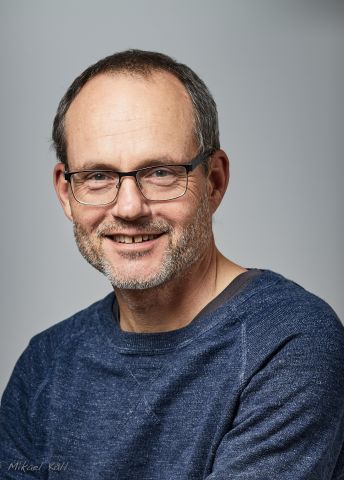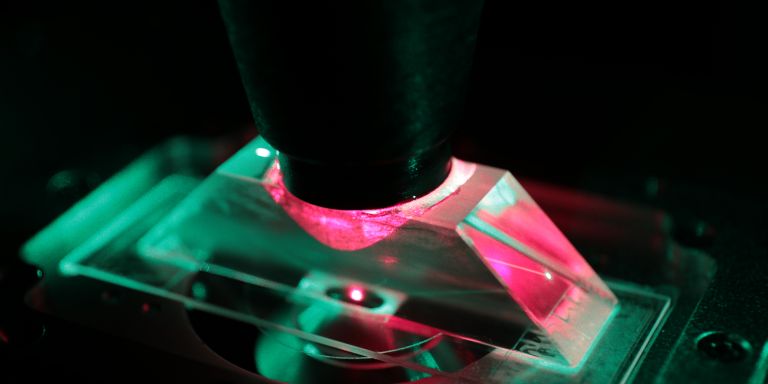
Mikael Käll
Professor of Physics
Wallenberg Scholar
Institution:
Chalmers University of Technology
Research field:
Physics


Wallenberg Scholar
Institution:
Chalmers University of Technology
Research field:
Physics
When Käll was chosen as a Wallenberg Scholar, one of his goals was to identify individual molecules, such as protein and virus particles, as a project in the field of bionanophotonics. This interdisciplinary field encompasses biology, nanoscience and various optical technologies.
Käll’s research team developed optical nanoantennas in the form of individual particles of gold or silver that can capture light. The antennas then amplify the light thousands of times over thanks to an optical phenomenon called plasmons. When a protein or a virus lands on the antenna it can be detected because it changes the refraction of the light.
“The sensor concepts are fairly well known and understood these days. Now I also want to use the light to induce a mechanical impact on the structures we can fabricate,” Käll says.
He calls the new field “active bionanophotonics”, and gives two examples from PhD theses written by members of his research team. In one, the light heats the optical antennas when they are lowered into a solution. The heat creates a bubble of steam, which drives a flow of liquid around the antenna.
“Simply put, it’s a way of ‘stirring the pot’. When you try to detect very low concentrations, you need to create a flow so the particles can be detected by the sensor. Otherwise it takes a really long time to detect an individual particle.”
The flow can be created using microfluidics, in which minute pumps propel liquid in plastic channels over the surface of the sensor. But this adds multiple technologies, which may cause unnecessary complications. If the sensor itself can create the flow, the technique will retain its simplicity.
“The main challenge has been to find ways of controlling the process that controls the flow of liquid, but we have now succeeded,” he says.
The other example involves converting the inherent power of light into mechanical power. Light is more than just energy; it also carries momentum in the direction of travel. This includes a torque capable of inducing something else to spin, and a linear moment that can be used to exert pressure on an object to make it move.
“These are purely optical forces that do not make the object heat up, but do cause it to react with so much counterforce that it moves,” Käll explains.
The research team has made a special material to capture the light’s momentum. A microparticle is given an ultra-thin coating, known as a “meta-surface”, which is made up of nanoparticles in a tailored structure. The meta-surface refracts the light in a given direction, imparting a counterforce to the microparticle and driving it forward.
“It might sound a little “spaced out” but we steer the particles around like tiny cars with the help of a plane wave of light. This is curiosity-driven research that may not be of any practical use, but it’s interesting to see how far we can pursue our ideas on transferring energy from light to matter,” Käll says.
This curiosity-driven research makes progress by combining different fields of research. Most of the work entails optical experiments, simulations, nanofabrication and design. The “bubble” example also involves thermodynamics and fluid dynamics.
“It’s a challenge, but that’s also what makes research so rewarding – learning new things all the time while entering uncharted territory,” Käll enthuses.
And there are also new applications in sight. Meta-surfaces can be used in numerous applications, e.g. to create completely flat camera lenses. But it is not the applications that drive Käll, but the scientific discussion.
“My impetus comes from the process itself. A grant like the Wallenberg Scholar funding plays a key part in this context, because it gives me absolute freedom to take whatever path I choose.”
“Being chosen as a Wallenberg Scholar is a marvelous acknowledgement, for which I am enormously grateful. And it creates a certain amount of pressure, so it’s a great privilege.”
He is assisted by a research team of about six people. It is important that the team does not outgrow itself.
“The limit is perhaps eight people. More than that and it would be difficult to interact properly with everyone. I’m not interested in empire-building – I want an environment where I can maintain a good overview.”
The conditions for research are another of his interests. He is a well-known deputy head of department at Chalmers University of Technology, specializing in research and policy issues.
“It’s interesting to try to understanding research in a wider perspective. How are we to achieve our results in the best way and with the highest quality, while ensuring research is performed ethically and sustainably?”
He also considers it his duty to be engaged; he has been successful in his research, which places him in an advantageous position.
“Quite a lot of my research has driven the field forward. What interests me most are the concepts, the ideas, and demonstrating new possibilities. It’s essential that research should not need to result in specific benefits, that it can be free of the constraints that implies,” Käll says.
Text Magnus Trogen Pahlén
Translation Maxwell Arding
Photo Daniel Andrén, Matjaž Golič, Anna-Lena Lundqvist
Project Grant 2020
Next-generation lasers with built-in optics
Project Grant 2012
Optical antennas that make the nanoworld visible